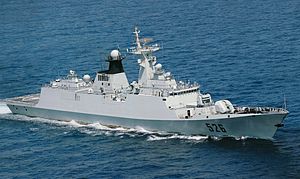Early on Thursday, a Chinese Navy frigate entered the contiguous zone adjacent to the 12 nautical mile Japanese territorial sea around the disputed Senkaku/Diaoyu Islands in the East China Sea.
According to a Kyodo report, citing the Japanese Defense Ministry, a Chinese frigate, identified as a Type 054 Jiankai-I-class, “ship entered the zone northeast of Kuba Island, part of the Senkakus, around 12:50 a.m.” The report adds:
The frigate left the zone from around Taisho Island, another part of the Senkakus, at about 3:10 a.m. and headed north, the ministry said, adding there was no intrusion into Japanese territorial waters.
While Chinese Coast Guard vessels have previously entered the contiguous zone near the Senkakus, which are administered by Japan, this is the first time China has sent a military vessel into the area.
It is unclear if the Chinese frigate engaged in any provocative behavior while in the contiguous zone.
Under the United Nations Convention on the Law of the Sea, which both Japan and China have ratified, military vessels are permitted legal passage through territorial waters provided they comply with innocent passage requirements, which prohibit a range of activities, including intelligence gathering.
States administering a contiguous zone are able to enforce customs, immigration, and other laws, but the zone does not afford the same degree of exclusivity as the 12 nautical mile territorial sea.
According to Kyodo, Japan’s Vice Foreign Minister Akitaka Saiki summoned China’s envoy to Tokyo to protest the incident.
Russian Angle
Curiously, Japan’s foreign ministry further reports that three Russian military vessels were spotted in the Senkaku contiguous zone around the same time as the Chinese vessel’s transit.
Japan and Russia have a separate territorial dispute over the sovereignty of the Kuril Islands, which are located off the northern coast of the Japanese island of Hokkaido, far away from the East China Sea.
Japanese Prime Minister Shinzo Abe met Russian President Vladimir Putin for an informal summit in Sochi in early May 2016; the two leaders were unable to deliver any signs of broader bilateral rapprochement.
Relations between Japan and Russia have been strained by a range of factors, including Tokyo’s willingness to work with the G7 to sanction and isolate Russia in the aftermath of Moscow’s 2014 annexation of Crimea from Ukraine.
It is unclear if the Chinese and Russian vessels were coordinating in this incident. Apart from noting the presence of Russian vessels, the Japanese foreign ministry has not implied any collaboration.
China and Russia held a May 2014 exercise in the East China Sea focused on “naval combat.” Last year, the two navies conducted drills in the Sea of Japan.
Earlier this year, in a similarly provocative move that Japan’s defense ministry highlighted, two Russian Tu-95MS “Bear” strategic bombers circumnavigated Japan’s main islands of Honshu, Kyushu, Shikoku, and Hokkaido.
Rising Tensions in the East China Sea?
The Japanese foreign ministry has made detailed data available on the numbers of Chinese government vessels that have entered Japan’s contiguous zone or territorial sea near the Senkaku Islands.
As tensions have heated up over the South China Sea, where China has drawn international scrutiny and criticism for its rapid construction of artificial islands, the East China Sea has grown relatively more placid, particularly compared to far more acute tensions and bilateral incidents that were apparent to regional security analysts in 2013 and early-2014.
This isn’t the first flare-up this week in the East China Sea. Yesterday, a U.S. RC-135 reconnaissance aircraft faced what U.S. officials described as an “unsafe” intercept attempt by a Chinese fighter in international airspace.
Moreover, last week, Japanese Foreign Minister Fumio Kishida lodged protest with the Chinese embassy over China’s continued construction of gas drilling rigs in the East China Sea despite the lack of finalization of 2008 bilateral agreement on the demarcation of a maritime boundary.
It is possible that the Chinese frigate’s entry into Japan’s contiguous zone near the Senkakus was a move intended to emphasize China’s displeasure with the Japanese move.
It is unclear why China would choose to escalate tensions with Japan in the East China Sea at a time when the South China Sea has grown particularly hot over U.S.-China disagreements over continued freedom of navigation operations and other activities.
Moreover, the South China Sea disputes are expected to only grow more tense as the summer of 2016 progresses, with a highly anticipated verdict expected soon out of the Permanent Court of Arbitration in Philippines v. China.
Beijing has shown a tendency to manage its provocative behavior vis-a-vis neighboring states in the East and South China Sea, largely avoiding simultaneous flare-ups across both seas.

































